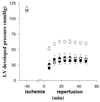Regular alcohol consumption mimics cardiac preconditioning by protecting against ischemia-reperfusion injury
- PMID: 9096376
- PMCID: PMC20352
- DOI: 10.1073/pnas.94.7.3235
Regular alcohol consumption mimics cardiac preconditioning by protecting against ischemia-reperfusion injury
Abstract
Epidemiologic studies indicate that long-term alcohol consumption decreases the incidence of coronary disease and may improve outcome after myocardial infarction. Attenuation of ischemia-reperfusion injury after myocardial infarction improves survival. This study investigates the possibility that alcohol consumption can improve survival after myocardial infarction by reducing ischemia-reperfusion injury. Hearts were isolated from guinea pigs after drinking ethanol for 3-12 weeks and subjected to global ischemia and reperfusion. Hearts from animals drinking ethanol showed improved functional recovery and decreased myocyte damage when compared with controls. Adenosine A1 receptor blockade abolished the protection provided by ethanol consumption. These findings indicate that long-term alcohol consumption reduces myocardial ischemia-reperfusion injury and that adenosine A1 receptors are required for this protective effect of ethanol. This cardioprotective effect of long-term alcohol consumption mimics preconditioning and may, in part, account for the beneficial effect of moderate drinking on cardiac health.
Figures


References
-
- Klatsky A L, Armstrong M A, Friedman G D. Am J Cardiol. 1990;66:1237–1242. - PubMed
-
- Rimm E B, Giovannucci E L, Willett W C, Colditz G A, Ascherio A, Rosner B, Stampfer M J. Lancet. 1991;338:464–468. - PubMed
-
- Fuchs C S, Stampfer M J, Colditz G A, Giovannucci E L, Manson J E, Kawachi I, Hunter D J, Hankinson S E, Hennekens C H, Rosner B, Speizer F E, Willett W C. N Engl J Med. 1995;332:1245–1250. - PubMed
-
- Gaziano J M, Buring J E, Breslow J L, Goldhaber S Z, Rosner B, VanDenburgh M, Willett W, Hennekens C H. N Engl J Med. 1993;329:1829–1834. - PubMed
Publication types
MeSH terms
Substances
Grants and funding
LinkOut - more resources
Full Text Sources
Medical

